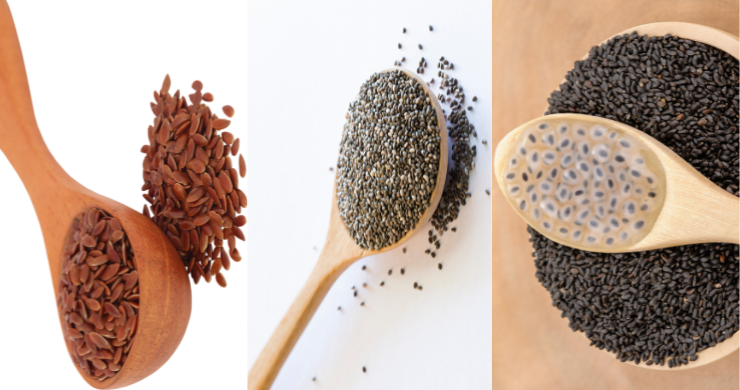Unlocking the Power of Chia, Flax, and Basil Seeds: Which Super Seed is Right for You?
If you’re over 30 and striving to maintain your health, chances are you’re looking for easy, natural ways to boost your well-being. Enter chia, flax, and basil seeds—three tiny but mighty superfoods that are often overlooked but pack a significant nutritional punch. Whether you’re aiming to improve digestion, enhance heart health, balance hormones, or simply get a steady stream of essential nutrients, these seeds offer a treasure trove of health benefits.
As we age, it becomes even more important to prioritize foods that support overall health, including fiber for digestion, omega-3 fatty acids for heart and brain function, and minerals like calcium and magnesium for strong bones and muscle function. Chia, flax, and basil seeds each shine in these areas, but they do so in slightly different ways. Let’s explore which seed might be the best fit for your lifestyle and nutritional goals.
Chia Seeds:
Known as the ancient fuel of Aztec warriors, chia seeds are rich in fiber and omega-3 fatty acids. These little powerhouses can support everything from digestion to inflammation reduction. Their gel-like consistency when soaked makes them excellent for weight management by keeping you full longer—perfect if you’re watching your waistline in your 30s,40s, 50s, and beyond.
Flax Seeds:
Flax seeds have been hailed for centuries as a hormone balancer, especially important for women entering menopause. Loaded with lignans, flax can help regulate estrogen levels while also providing ample omega-3s to keep your heart and brain functioning at their best. For men, the fiber and antioxidant content can aid in prostate health and reduce inflammation.
Basil Seeds:
While less well-known, basil seeds (often called sabja seeds) offer unique benefits. They are packed with fiber, help cool the body, and are often used in Ayurvedic practices to aid digestion. Their ability to swell and form a gel in water—similar to chia seeds—makes them excellent for keeping blood sugar levels steady and supporting weight management.
In this post, we’ll dive deep into the nutritional profiles of each of these seeds and compare their benefits. Whether you’re looking to add more fiber to your diet, support hormone balance, or enhance your cardiovascular health, you’ll walk away knowing exactly which seed will best support your body’s needs as you continue your health journey. Ready to unlock the potential of these super seeds? Let’s get started!
Let’s compare the fiber content and nutritional makeup of chia seeds, flax seeds, and basil seeds. I’ll break it down into key nutrients like fiber, omega-3 fatty acids, protein, and micronutrients per 28g (1-ounce) serving of each seed.
-
Chia Seeds (28g)
Chia seeds are a popular superfood known for their high fiber and omega-3 fatty acid content.
| Nutrient | Amount |
| Calories | 137 kcal |
| Total Fat | 8.6g |
| Omega-3 (ALA) | 5g |
| Protein | 4.7g |
| Total Carbs | 12g |
| Dietary Fiber | 10g |
| Calcium | 179mg (14% DV) |
| Magnesium | 95mg (23% DV) |
| Phosphorus | 244mg (35% DV) |
| Potassium | 115mg (3% DV) |
-
Key Highlights
: Chia seeds are particularly high in fiber and omega-3 fatty acids (ALA). About 40% of their carbs come from fiber, making them an excellent seed for gut health and maintaining low net carbs on keto.
-
Flax Seeds (28g)
Flax seeds are another excellent source of omega-3s and fiber, and they offer additional benefits for hormone health due to their lignan content.
| Nutrient | Amount |
| Calories | 150 kcal |
| Total Fat | 12g |
| Omega-3 (ALA) | 6.4g |
| Protein | 5.2g |
| Total Carbs | 8g |
| Dietary Fiber | 7.6g |
| Calcium | 72mg (6% DV) |
| Magnesium | 110mg (27% DV) |
| Phosphorus | 180mg (25% DV) |
| Potassium | 230mg (5% DV) |
- Key Highlights: Flax seeds are also rich in omega-3 fatty acids but have slightly less fiber compared to chia seeds. They are notable for their lignans, which may have antioxidant and hormone-balancing properties.
-
Basil Seeds (28g)
Basil seeds, also known as tukmaria or sabja seeds, are less commonly used but have similar swelling properties to chia seeds when soaked in water.
| Nutrient | Amount |
| Calories | 60 kcal |
| Total Fat | 2.5g |
| Omega-3 (ALA) | 1.6g |
| Protein | 2g |
| Total Carbs | 7g |
| Dietary Fiber | 7g |
| Calcium | 15% DV |
| Magnesium | 10% DV |
| Phosphorus | 10% DV |
| Potassium | 4% DV |
- Key Highlights: Basil seeds are lower in calories and fat than chia and flax seeds but still offer a good amount of fiber. Their omega-3 content is lower, but they do provide a notable amount of calcium and magnesium.
Comparison Summary:
| Nutrient | Chia Seeds | Flax Seeds | Basil Seeds |
| Calories | 137 kcal | 150 kcal | 60 kcal |
| Total Fat | 8.6g | 12g | 2.5g |
| Omega-3 (ALA) | 5g | 6.4g | 1.6g |
| Protein | 4.7g | 5.2g | 2g |
| Total Carbs | 12g | 8g | 7g |
| Dietary Fiber | 10g | 7.6g | 7g |
| Calcium | 179mg (14% DV) | 72mg (6% DV) | 15% DV * |
| Magnesium | 95mg (23% DV) | 110mg (27% DV) | 10% DV * |
| Phosphorus | 244mg (35% DV) | 180mg (25% DV) | 10% DV * |
| Potassium | 115mg (3% DV) | 230mg (5% DV) | 4% DV * |
Key Takeaways:
- Chia seeds have the highest fiber content (10g) and are rich in omega-3s, making them ideal for digestion and maintaining keto-friendly net carbs.
- Flax seeds offer the most omega-3 fatty acids and have a slightly lower fiber content, but they provide additional benefits like lignans.
- Basil seeds are lower in fat and calories but still provide a good amount of fiber and are easier on the stomach for some people. They also contain notable amounts of calcium and magnesium.
Each of these seeds can be valuable depending on your dietary needs, but chia and flax are more potent in terms of omega-3 content and overall nutrient density.
* DV stands for Daily Value, which is a guide to the nutrients in one serving of food. It’s expressed as a percentage and helps you understand how much a nutrient in a serving of food contributes to your daily diet. The Daily Values are based on a 2,000-calorie diet for general nutritional advice.
For example, if something provides 10% DV of calcium, that means one serving gives you 10% of the total calcium you should ideally consume in a day, assuming you’re following a 2,000-calorie diet. Keep in mind that individual needs may vary based on factors like age, gender, and activity level.



